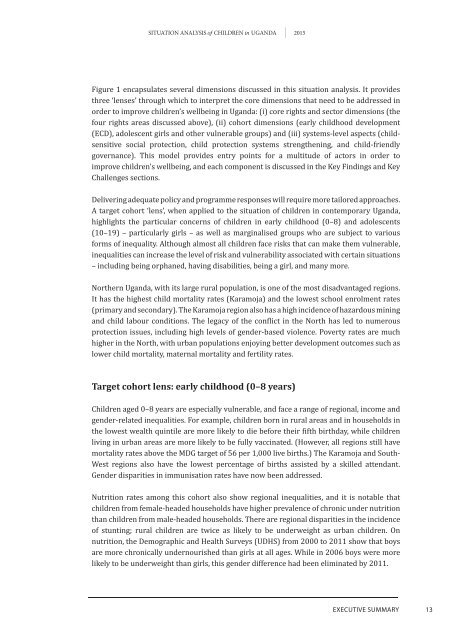Situation analySiS
1TNu802
1TNu802
Create successful ePaper yourself
Turn your PDF publications into a flip-book with our unique Google optimized e-Paper software.
<strong>Situation</strong> <strong>analySiS</strong> of Children in uganda 2015Figure 1 encapsulates several dimensions discussed in this situation analysis. It providesthree ‘lenses’ through which to interpret the core dimensions that need to be addressed inorder to improve children’s wellbeing in Uganda: (i) core rights and sector dimensions (thefour rights areas discussed above), (ii) cohort dimensions (early childhood development(ECD), adolescent girls and other vulnerable groups) and (iii) systems-level aspects (childsensitivesocial protection, child protection systems strengthening, and child-friendlygovernance). This model provides entry points for a multitude of actors in order toimprove children’s wellbeing, and each component is discussed in the Key Findings and KeyChallenges sections.Delivering adequate policy and programme responses will require more tailored approaches.A target cohort ‘lens’, when applied to the situation of children in contemporary Uganda,highlights the particular concerns of children in early childhood (0–8) and adolescents(10–19) – particularly girls – as well as marginalised groups who are subject to variousforms of inequality. Although almost all children face risks that can make them vulnerable,inequalities can increase the level of risk and vulnerability associated with certain situations– including being orphaned, having disabilities, being a girl, and many more.Northern Uganda, with its large rural population, is one of the most disadvantaged regions.It has the highest child mortality rates (Karamoja) and the lowest school enrolment rates(primary and secondary). The Karamoja region also has a high incidence of hazardous miningand child labour conditions. The legacy of the conflict in the North has led to numerousprotection issues, including high levels of gender-based violence. Poverty rates are muchhigher in the North, with urban populations enjoying better development outcomes such aslower child mortality, maternal mortality and fertility rates.Target cohort lens: early childhood (0–8 years)Children aged 0–8 years are especially vulnerable, and face a range of regional, income andgender-related inequalities. For example, children born in rural areas and in households inthe lowest wealth quintile are more likely to die before their fifth birthday, while childrenliving in urban areas are more likely to be fully vaccinated. (However, all regions still havemortality rates above the MDG target of 56 per 1,000 live births.) The Karamoja and South-West regions also have the lowest percentage of births assisted by a skilled attendant.Gender disparities in immunisation rates have now been addressed.Nutrition rates among this cohort also show regional inequalities, and it is notable thatchildren from female-headed households have higher prevalence of chronic under nutritionthan children from male-headed households. There are regional disparities in the incidenceof stunting; rural children are twice as likely to be underweight as urban children. Onnutrition, the Demographic and Health Surveys (UDHS) from 2000 to 2011 show that boysare more chronically undernourished than girls at all ages. While in 2006 boys were morelikely to be underweight than girls, this gender difference had been eliminated by 2011.ExECUtIvE SUMMary13




